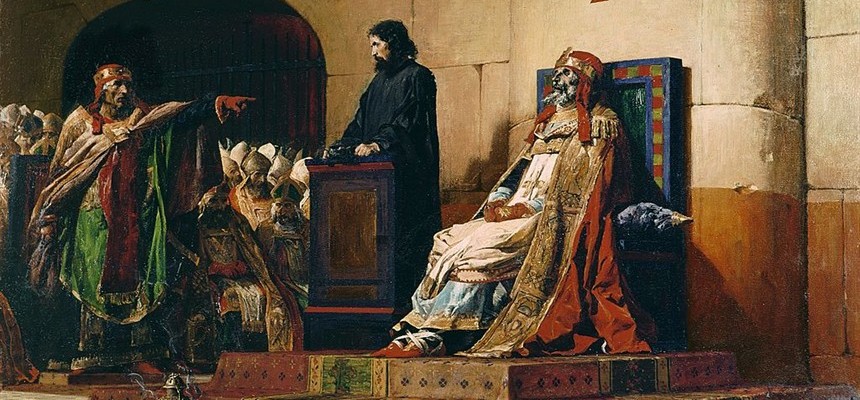
A man known to be religious, moral, ascetic and an intellectual, Formosus did not fare well in the history books. Born around 816, Formosus spent his life in the Church but, much to his chagrin, did not have a calm life.
Pope Nicholas I (858-867) appointed Formosus cardinal-bishop of Porto, the seacoast port for Rome, in 864. He was then sent as legate to Bulgaria in 866, when Sts. Cyril and Methodius were in the midst of their great evangelization. He was so well liked that the ruler of Bulgaria wrote to Pope Nicholas asking him to transfer Formosus to the archbishopric of Bulgaria. Due to rules that a bishop can not change dioceses, Nicholas refused the request.
The cardinal-bishop also served as legate to France in 869 and 872, proving himself to be a very trust-worthy man.
In 872, Formosus was one of the candidates for the open papacy, which John VIII eventually won. This was the start of a very dark period in Western Europe. Emperor Louis II died in 875. His uncle, Charles the Bald, was elected the new emperor. Formosus was charged by Pope John with inviting Charles to be crowned in Rome. Unfortunately, Louis the German and Louis II’s widow opposed the coronation. There were many in Pope John’s retinue who agreed with them. These supporters feared political retribution and felt the need to flee Rome. Formosus went to Tours, France.
In April of 876, Pope John called a synod to force the officials back. If they did not return, there would be punishments. Formosus was warned he would be deprived of his priestly rights and excommunicated. He was charged with deserting his diocese without papal permission, having aspirations to the archbishopric of Bulgaria, opposing the emperor, conspiring to destroy the Papal See and robbing the cloisters on his way out of town. It looks like John VIII was afraid of Formosus as a formidable adversary. On June 30 of the same year, Formosus had not returned and the punishment was completed.
Almost two years later, Pope John went to Troyes and met with Formosus where the ex-bishop took an oath to not say Mass or hear confessions. After the death of John VIII, Pope Marinus (882-884) released Formosus from his oath and returned him to the bishopric of Porto.
Pope Stephen V died in 891 and Formosus was unanimously elected in September. The trouble under Stephen continued under Formosus:
The Saracens attacked the Lazio region, just south of Rome, too often.
Photius, the Patriarch of Constantinople was ejected and Stephen, son of Emperor Basilius was elevated. Thus began the problem of determining if Photius was a true bishop or not, and, if not, were the priests he ordained true priests. And how about the priests they ordained? They were all to resign!
After Charles the Fat was deposed and died in 887, Arnulf of Carpathia could not keep the unity that Charles had worked for. There were too many of Charlemagne’s descendants trying to become king and emperor. Berengar of Frieul was defeated by Guy of Spoleto, who, thereby, ruled half of Italy. Stephen V had unwittingly permitted Guy to be emperor even though he preferred Arnulf. Formosus ended up having to crown Guy and his young son co-emperors in April, 892.
The German bishops got into some disagreements. Guy supported the Germans against the Pope. Guy, who, like previous Spoleto dukes, had a distaste for the Papal States, unless the land belonged to them, now ruled up to the borders. Formosus was so fearful, he asked Arnulf to liberate Rome. By the summer of 894, Arnulf had taken the land north of the River Po. Guy died within months. The young emperor, Lambert, and his mother, Agiltrude, were very anti-Arnulf. In the fall of 895, Arnulf started his second campaign and by February, 896, he was at the walls of Rome. He entered and Formosus crowned Arnulf, emperor, despite Lambert still being alive. The new emperor headed for Spoleto, but he suffered a stroke on the way.
Formosus died less than two months later. But that was not the end of his earthly trouble.

Available in paperback at Amazon

Recent Comments